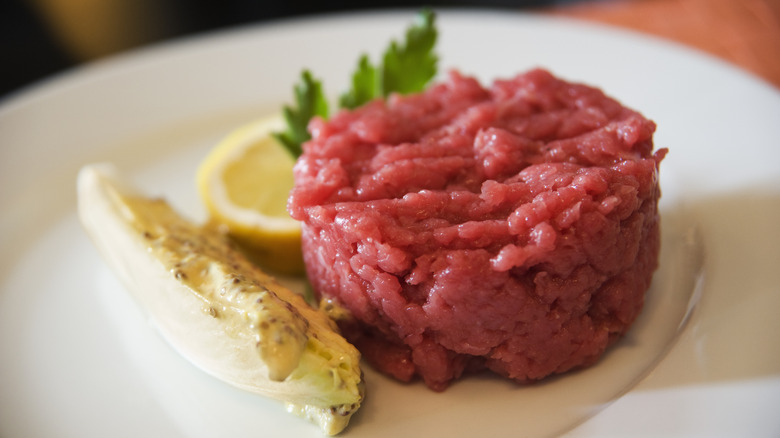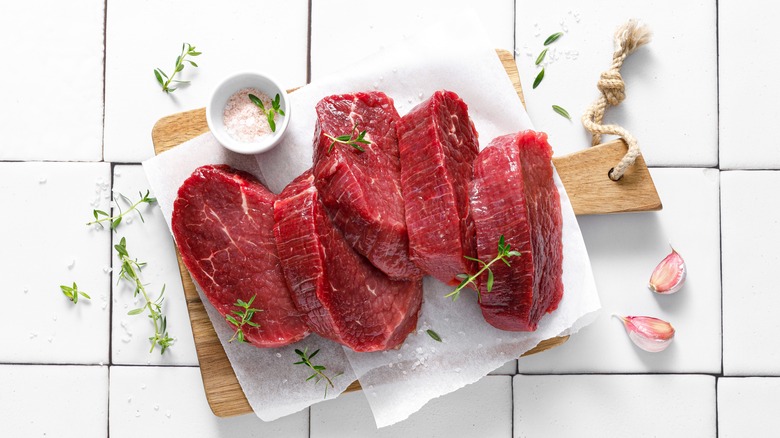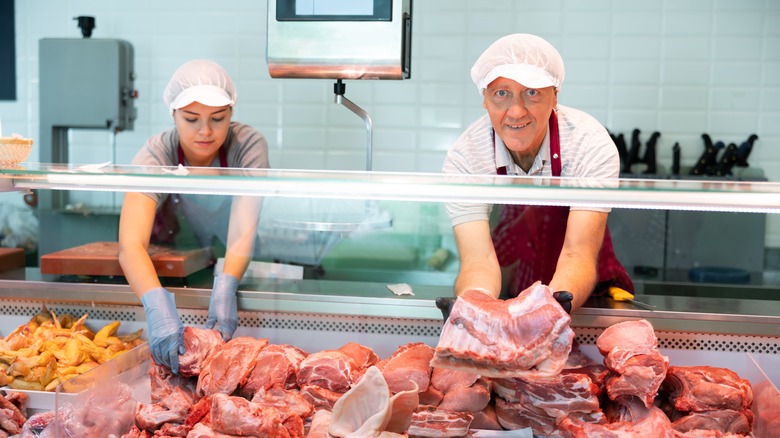How To Buy Meat For Impressive Homemade Steak Tartare
Steak tartare (sometimes called beef tartare) has become a staple on all sorts of restaurant menus, far beyond the types of French restaurants that have always served it. But if you're tempted to recreate this dish at home, you'll need to be careful and attentive when buying the meat for steak tartare. Obviously, you'll want to source high-quality meat so you have a flavorful dish. More importantly, though, since you're working with raw meat that has a higher risk for causing food poisoning, you'll want to seek out meat that has the lowest likelihood of containing pathogens like E.coli that would otherwise be killed off in the cooking process.
The first step is choosing where to buy your meat. Going to a specialty butcher would be a wise idea, rather than just picking up meat from the supermarket. You'll generally find higher quality meat in a butcher shop (although naturally, the quality varies between stores), as compared to a supermarket, where meat is sourced from lower-grade factory farms and tends to be less fresh (for example, sitting on the refrigerator shelf for a while). The high quantity of meat moving through both factory farms and supermarkets leaves open more room for contamination, versus a butcher shop, where it'll likely be handled more carefully and with lower likelihood of cross-contamination.
What types of beef to buy and to avoid
Choosing meat for steak tartare isn't just about heading to the right store — it's also a matter of selecting the right cuts of beef. Starting generally, you'll want a tender cut of beef — since there's no cooking involved, there's no opportunity to soften up tough beef with heat. Anything with connective tissue is not ideal, like brisket or chuck — these come from areas of the cow that move a lot, toughening up the meat.
Leaner cuts are generally better — this way you avoid getting any gristle in your tartare. For example, Martha Stewart recommends tenderloin (as do plenty of other recipes). Top sirloin is another good choice, and it's what Alton Brown uses in his recipe. It's also light on fat, and as a bonus, is somewhat cheaper than tenderloin. Also on the more affordable side is top round: It's from a slightly tougher part of the animal, but is still light on fat and tasty. More generally, go for meat that's as bright red in color as possible, as it's the freshest.
General safety tips to know for steak tartare
Officially speaking, the USDA advises against eating steak tartare, firmly recommending that all beef be cooked to 145 to 160 degrees Fahrenheit before consumption. In reality, tartare is usually safe as long as you're careful with hygiene. Sourcing the right meat is important, but it's also important to store it properly: Keep it refrigerated until right before you prepare it. You'll also want to use perfectly clean knives and cutting boards to ensure no pathogens get in — if all this is done properly, your shouldn't have anything to worry about before tucking into that classic French tartare.
Finally, there's the question of ground beef. While many tartare recipes don't call for ground meat (instead suggesting that you chop up cuts like tenderloin), there are tartare-adjacent dishes out there that do use it — for example, the "cannibal sandwich" that you might find in Wisconsin. Generally speaking, you should avoid ground meat for any kind of raw beef dish, as a lot of different cuts of beef from different sources can be fed through a meat grinder, which can be a serious food safety issue if you're using that meat without cooking it. Theoretically, you could use ground beef if it comes from one single cut of beef and is run through a clean grinder, although this may require you to do it yourself at home.


